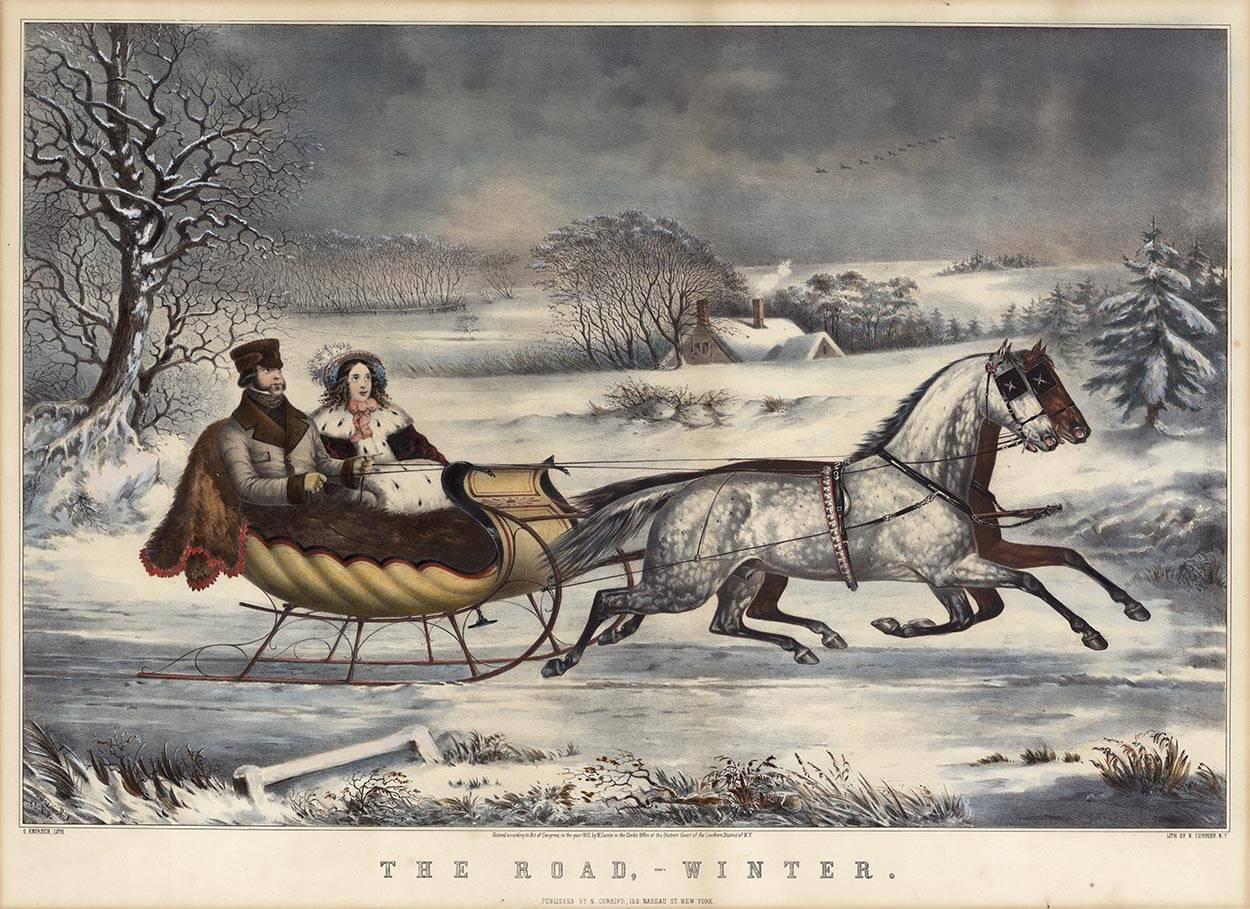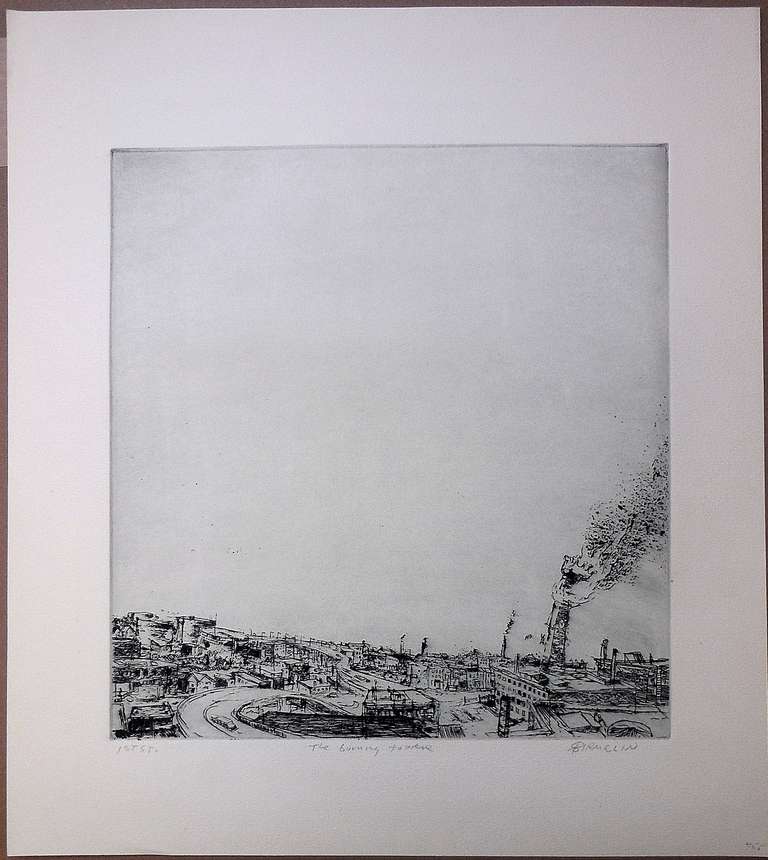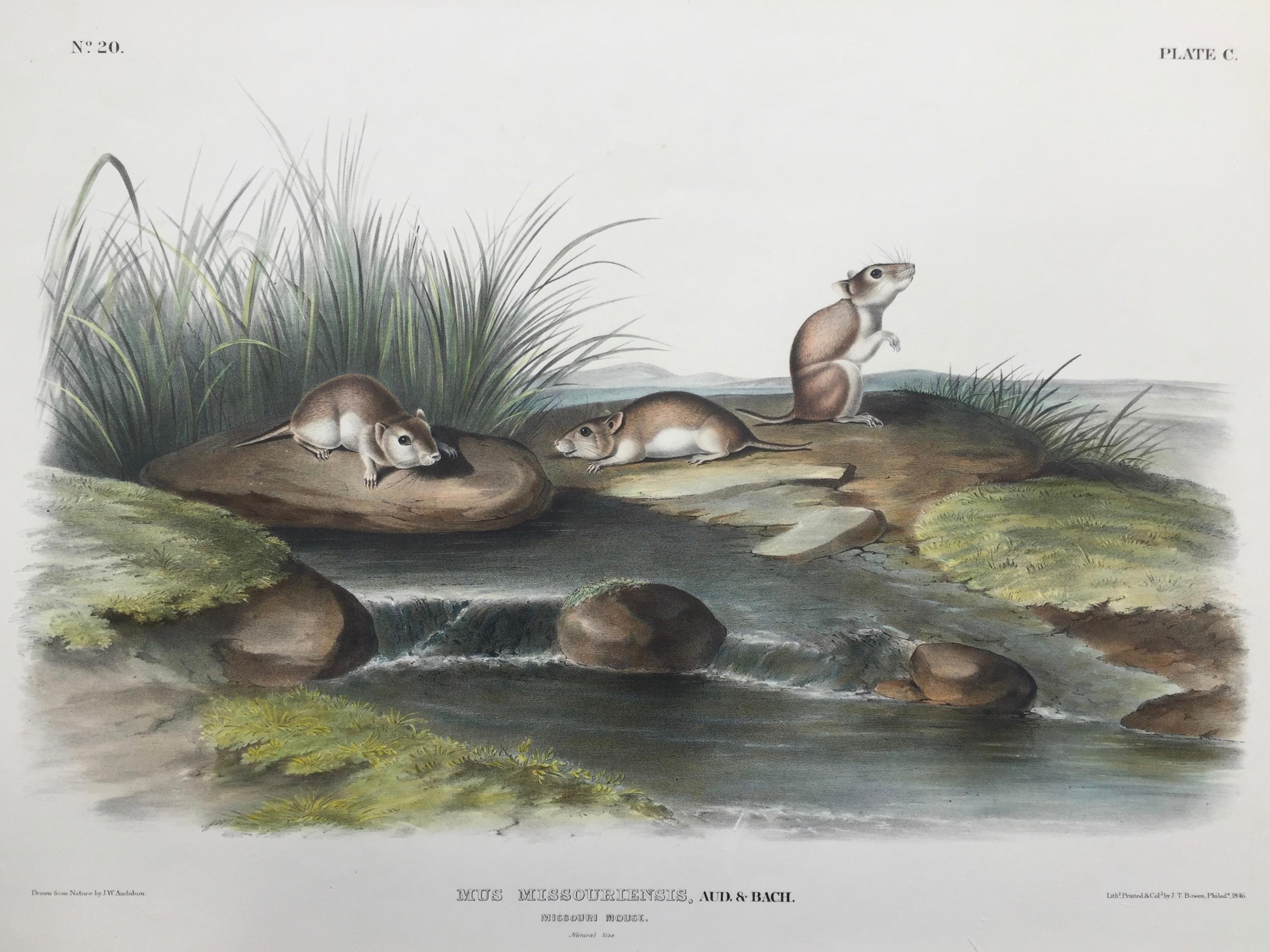Items Similar to Mt Lassen, Northern California, Black & White Lithograph Mountain Landscape
Video Loading
Want more images or videos?
Request additional images or videos from the seller
1 of 18
Walter DuBois RichardsMt Lassen, Northern California, Black & White Lithograph Mountain Landscape
About the Item
Mt Lassen, original vintage signed lithograph by Richard Walter Dubois (1907-2006) of a Northern California landscape with pine trees, snow-capped mountains and dramatic storm clouds, black and white, signed lower right, numbered 19 in an edition of 20 prints lower center, titled lower left. Presented in a custom frame, outer dimensions measure 32 ½ x 25 ¼ x ¾ inches. Image size is 21 x 14 ¾ inches.
Print is clean and in very good vintage condition - please contact us for a detailed condition report.
Lassen Peak, commonly referred to as Mount Lassen, is the southernmost active volcano in the Cascade Range of the Western United States. Located in the Shasta Cascade region of Northern California, it is part of the Cascade Volcanic Arc, which stretches from southwestern British Columbia to northern California.
Expedited and international shipping is available - please contact us for a quote.
About the Artist:
Walter DuBois Richards graduated from the Cleveland School of Art and moved to New York in 1936,where he created illustrations for Madison Avenue advertising accounts and national publications. A gifted draftsman, watercolorist, and lithographer, he has traveled the world on assignment for Life magazine, the U.S. Air Force, and many American corporations. His paintings have been exhibited at the Metropolitan Museum of Art and are included in the permanent collections of the Whitney Museum of American Art, the New Britain Museum, and the Pentagon. His 37 U.S. stamps
include a series honoring 16 national architectural treasures.
- Creator:Walter DuBois Richards (1907 - 2006, American)
- Dimensions:Height: 32.5 in (82.55 cm)Width: 25.25 in (64.14 cm)Depth: 0.75 in (1.91 cm)
- Medium:
- Movement & Style:
- Period:
- Framing:Frame IncludedFraming Options Available
- Condition:very good to excellent condition.
- Gallery Location:Denver, CO
- Reference Number:
Walter DuBois Richards
Walter DuBois Richards graduated from the Cleveland School of Art and moved to New York in 1936, where he created illustrations for Madison Avenue advertising accounts and national publications. A gifted draftsman, watercolorist, and lithographer, he has traveled the world on assignment for Life magazine, the U.S. Air Force, and many American corporations. His paintings have been exhibited at the Metropolitan Museum of Art and are included in the permanent collections of the Whitney Museum of American Art, the New Britain Museum, and the Pentagon. His 37 U.S. stamps include a series honoring 16 national architectural treasures.
About the Seller
5.0
Platinum Seller
These expertly vetted sellers are 1stDibs' most experienced sellers and are rated highest by our customers.
Established in 1979
1stDibs seller since 2013
265 sales on 1stDibs
Typical response time: 5 hours
- ShippingRetrieving quote...Ships From: Denver, CO
- Return PolicyA return for this item may be initiated within 7 days of delivery.
More From This SellerView All
- Prospector's Cabin, 1930s WPA Era Modernist Black White Framed LithographBy Archie MusickLocated in Denver, COOriginal, signed lithograph titled "Prospector's Cabin" circa 1937 by American Modernist, Archie Musick. WPA era black and white print of a stone cabin among a mountain landscape wit...Category
1930s American Modern Landscape Prints
MaterialsLithograph
- House at Gregory Point (Colorado), 1930s Black and White Landscape LithographBy Arnold RönnebeckLocated in Denver, COOriginal Arnold Ronnebeck (1885-1947) lithograph of a home in Gregory Point, near Central City, Colorado from the 1930s. Edition of 25 printed. Presented in a custom frame, outer dimensions measure 23 ¼ x 18 ½ inches. Image size is 19 ¼ x 13 ¼ inches Print is clean and in very good vintage condition - please contact us for a detailed condition report. Provenance: Estate of Arnold Ronnebeck Expedited and international shipping is available - please contact us for a quote. About the Artist: Modernist sculptor, lithographer and museum administrator, Rönnebeck was a noted member of European and American avant-garde circles in the early twentieth century before settling in Denver, Colorado, in 1926. After studying architecture at the Royal Art School in Berlin for two years beginning in 1905, he moved to Paris in 1908 to study sculpture with Aristide Maillol and Émile-Antoine Bourdelle. While there he met and befriended American modernist painter, Marsden Hartley, of whom he sculpted a bronze head that was exhibited at the Salon d’Automne in Paris in 1912 and the following year at Hartley’s solo show of paintings at Alfred Stieglitz’s Gallery 291 in New York. A frequent guest of Gertrude Stein’s Saturday "evenings" in Paris, she described Rönnebeck as "charming and always invited to dinner," along with Pablo Picasso, Mabel Dodge (Luhan) and Charles Demuth. After the outbreak of World War I in 1914, Rönnebeck returned to Germany where he served as an officer in the German Imperial Army on the front lines. Twice wounded, including in the Battle of Marne in France, Kaiser Wilhelm II awarded him the Iron Cross. During the war Hartley fell in love with Rönnebeck’s cousin, Lieutenant Karl von Freyburg, who was killed in combat. As a tribute to Freyburg, Hartley created Portrait of a German Officer (1914) now in the Metropolitan Museum of Art in New York. After the war Rönnebeck traveled in Italy with German writer, Max Sidow, and German poet, Theodor Daubler, doing a series of drawings of Positano and the Amalfi Coast that formed the basis for his lithographs on the subject. The death of his finacée, the young American opera singer Alice Miriam in 1922 and his own family’s increasing financial problems in post-World War I Germany led him to immigrate to the United States in 1923. After living briefly with Miriam’s family in Washington, DC, he moved to New York where he became part of the avant-garde circle around Alfred Stieglitz. His essay, "Through the Eyes of a European Sculptor," appeared in the catalog for the Anderson Gallery exhibition, "Alfred Stieglitz Presents Seven Americans: 159 Paintings, Photographs & Things, Recent & Never Publicly Shown, by Arthur G. Dove, Marsden Hartley, John Marin, Charles Demuth, Paul Strand, Georgia O’Keeffe, Alfred Stieglitz." In New York Rönnebeck began producing Precisionist-style lithographs of the city’s urban landscapes which he termed "living cubism." Some of them were reproduced in Vanity Fair magazine. Through Stieglitz he met Erhard Weyhe head of the Weyhe Gallery who, with its director Carl Zigrosser, arranged Rönnebeck’s first solo American exhibition in May 1925 at the gallery in New York. Comprising some sixty works – prints, drawings and sculpture – the show subsequently traveled on a thirteen-month tour of major American cities. Until the end of his life, the gallery represented him, along with other American artists Adolf Dehn, Wanda Gag, Rockwell Kent, J.J. Lankes, Louis Lozowick, Reginald Marsh and John Sloan. In the summer of 1925, as the guest of Mabel Dodge Luhan, Rönnebeck first saw Taos, New Mexico, which Marsden Hartley had encouraged him to visit. It was there that he met his future wife, Louise Emerson, an easel painter and muralist. A year later they were married in New York before relocating to Denver. He served as director of the Denver Art Museum from 1926 to 1930 where he invited Marsden Hartley to lecture on Cézanne’s art in 1928. Rönnebeck fostered the development of the museum’s collection of American Indian art and the curation of modernist art exhibitions. In addition to his work at the museum, he was professor of sculpture at the University of Denver’s College of Fine and Applied Arts from 1929 to 1935, and wrote a weekly art column in the Rocky Mountain News. His best known Denver sculptures from the late 1920s in bronze, copper, stone, wood and terra cotta include a reredos, The Epiphany, at St. Martin’s Chapel; The History of Money (six panels) at the Denver National Bank; The Ascension at the Church of Ascension; and the William V. Hodges Family Memorial at Fairmount Cemetery. At the same time he did a series of terra cotta relief panels for La Fonda Hotel in Santa Fe, New Mexico. In the 1930s his bas-relief aluminum friezes of stylized Pueblo and Hopi Indian Kachina masks...Category
1930s American Modern Landscape Prints
MaterialsPaper, Lithograph
- Gem Mining Company, Colorado Landscape Mining Scene 1930s Lithograph PrintBy Arnold RönnebeckLocated in Denver, CO'Gem Mining Company', lithograph by Arnold Ronnebeck from 1932. Colorado mining scene with several mining buildings amongst the mountains. Presented in...Category
1930s American Modern Landscape Prints
MaterialsLithograph
- Colorado Gold Dredge, Breckenridge, Signed Black and White Mining LithographBy Arnold RönnebeckLocated in Denver, COLithograph on paper titled 'Colorado Gold Dredge, Breckenridge' by Arnold Ronnebeck (1885-1947) from 1932. Numbered 15/25. Depicted is a gold dredge in Colorado mining town Breckenridge with a mountain landscape in the background. Presented in a custom frame measuring 17 ¼ x 21 ¼ inches. Image size measures 10 ¼ x 14 ¼ inches. Print is clean and in very good vintage condition - please contact us for a detailed condition report. Provenance: Estate of Arnold Ronnebeck Expedited and international shipping is available - please contact us for a quote. About the Artist: Modernist sculptor, lithographer and museum administrator, Rönnebeck was a noted member of European and American avant-garde circles in the early twentieth century before settling in Denver, Colorado, in 1926. After studying architecture at the Royal Art School in Berlin for two years beginning in 1905, he moved to Paris in 1908 to study sculpture with Aristide Maillol and Émile-Antoine Bourdelle. While there he met and befriended American modernist painter, Marsden Hartley, of whom he sculpted a bronze head that was exhibited at the Salon d’Automne in Paris in 1912 and the following year at Hartley’s solo show of paintings at Alfred Stieglitz’s Gallery 291 in New York. A frequent guest of Gertrude Stein’s Saturday "evenings" in Paris, she described Rönnebeck as "charming and always invited to dinner," along with Pablo Picasso, Mabel Dodge (Luhan) and Charles Demuth. After the outbreak of World War I in 1914, Rönnebeck returned to Germany where he served as an officer in the German Imperial Army on the front lines. Twice wounded, including in the Battle of Marne in France, Kaiser Wilhelm II awarded him the Iron Cross. During the war Hartley fell in love with Rönnebeck’s cousin, Lieutenant Karl von Freyburg, who was killed in combat. As a tribute to Freyburg, Hartley created Portrait of a German Officer (1914) now in the Metropolitan Museum of Art in New York. After the war Rönnebeck traveled in Italy with German writer, Max Sidow, and German poet, Theodor Daubler, doing a series of drawings of Positano and the Amalfi Coast that formed the basis for his lithographs on the subject. The death of his finacée, the young American opera singer Alice Miriam in 1922 and his own family’s increasing financial problems in post-World War I Germany led him to immigrate to the United States in 1923. After living briefly with Miriam’s family in Washington, DC, he moved to New York where he became part of the avant-garde circle around Alfred Stieglitz. His essay, "Through the Eyes of a European Sculptor," appeared in the catalog for the Anderson Gallery exhibition, "Alfred Stieglitz Presents Seven Americans: 159 Paintings, Photographs & Things, Recent & Never Publicly Shown, by Arthur G. Dove, Marsden Hartley, John Marin, Charles Demuth, Paul Strand, Georgia O’Keeffe, Alfred Stieglitz." In New York Rönnebeck began producing Precisionist-style lithographs of the city’s urban landscapes which he termed "living cubism." Some of them were reproduced in Vanity Fair magazine. Through Stieglitz he met Erhard Weyhe head of the Weyhe Gallery who, with its director Carl Zigrosser, arranged Rönnebeck’s first solo American exhibition in May 1925 at the gallery in New York. Comprising some sixty works – prints, drawings and sculpture – the show subsequently traveled on a thirteen-month tour of major American cities. Until the end of his life, the gallery represented him, along with other American artists Adolf Dehn, Wanda Gag, Rockwell Kent, J.J. Lankes, Louis Lozowick, Reginald Marsh and John Sloan. In the summer of 1925, as the guest of Mabel Dodge Luhan, Rönnebeck first saw Taos, New Mexico, which Marsden Hartley had encouraged him to visit. It was there that he met his future wife, Louise Emerson, an easel painter and muralist. A year later they were married in New York before relocating to Denver. He served as director of the Denver Art Museum from 1926 to 1930 where he invited Marsden Hartley to lecture on Cézanne’s art in 1928. Rönnebeck fostered the development of the museum’s collection of American Indian art and the curation of modernist art exhibitions. In addition to his work at the museum, he was professor of sculpture at the University of Denver’s College of Fine and Applied Arts from 1929 to 1935, and wrote a weekly art column in the Rocky Mountain News. His best known Denver sculptures from the late 1920s in bronze, copper, stone, wood and terra cotta include a reredos, The Epiphany, at St. Martin’s Chapel; The History of Money (six panels) at the Denver National Bank; The Ascension at the Church of Ascension; and the William V. Hodges Family Memorial at Fairmount Cemetery. At the same time he did a series of terra cotta relief panels for La Fonda Hotel in Santa Fe, New Mexico. In the 1930s his bas-relief aluminum friezes of stylized Pueblo and Hopi Indian Kachina masks...Category
1930s American Modern Landscape Prints
MaterialsLithograph, Paper
- 1940s Vertical American Modern Mining Town Landscape Lithograph, Mountain SceneBy Otis DozierLocated in Denver, COLithograph titled "Mining Town" by Otis Dozier (1904-1987) from 1940. Modernist scene of a mountain mining town with several buildings at the base of the mountain. Presented in a custom black frame, outer dimensions measure 25 ½ x 18 ⅜ x ¼ inches. Image sight size is 16 ¼ x 9 ½ inches. Print is clean and in very good condition - please contact us for a detailed condition report. Provenance: Private Collection, Denver, Colorado Expedited and international shipping is available - please contact us for a quote. About the Artist: Born in Forney, Texas, Otis Marion Dozier was raised on a farm in Mesquite, Texas. Dozier was a muralist, potter, lithographer, sculptor, and painter. Dozier was a member of a group of Texas regionalist artists known as the "Dallas Nine." His surroundings in Texas became the focus of much of his art. Dozier’s first artistic training took place in the early 1920’s when his family moved to Dallas. He studied under Vivian Aunspaugh, Cora Edge, and Frank Reaugh...Category
1940s Abstract Abstract Prints
MaterialsPaper, Lithograph
- 1930s Colorado Mountain Landscape Lithograph, Clear Creek Canyon by Ross BraughtBy Ross Eugene BraughtLocated in Denver, COOriginal lithograph by Ross Eugene Braught (1898-1983) titled 'Clear Creek Canyon I (Colorado)' from 1933. Pencil signed by the artist in the lower right margin. Presented in a custom frame with all archival materials measuring 26 ½ x 31 ½ inches, image size is 16 x 23 inches. Clear Creek rises near Loveland Pass...Category
1930s American Modern Landscape Prints
MaterialsArchival Paper, Pencil, Lithograph
You May Also Like
- The Road, - Winter.By Otto KnirschLocated in New York, NYPublished by N. Currier, 152 Nassau St. New York. Drawn on the stone by O. Knirsch. Lithograph hand-colored, 1853. This print was produced by Nathaniel Currier's staff as a Christ...Category
19th Century American Realist Landscape Prints
MaterialsLithograph
- The Burning TowerBy Robert A. BirmelinLocated in Surfside, FLBorn in Newark, New Jersey, Robert Birmelin became a professor of fine arts at Queens College in New York, and is known for paintings that magnify through texture the realism of natu...Category
20th Century American Realist Landscape Prints
MaterialsLithograph
- MISSOURI MOUSE - Large Folio "The Viviparous Quadrupeds of North America" Pl.100By After John James AudubonLocated in Santa Monica, CA(After) JOHN JAMES AUDUBON (1785 - 1851) MISSOURI MOUSE, 1846 - Plate 100 (C) No. 20 Lithograph with original hand coloring. From Audubon's "The Viviparous Quadrupeds of North America...Category
1840s American Realist Landscape Prints
MaterialsLithograph
- Mountain SceneBy Ira MoskowitzLocated in New York, NYIra Moskowitz (1912-1985), [Mountain Scene], 1943, lithograph, signed in pencil lower right, numbered lower left (27/50) [also signed and dated 1943 in ...Category
1940s American Realist Landscape Prints
MaterialsLithograph
- New York Skyline, SketchBy John Taylor ArmsLocated in Myrtle Beach, SCA fine impression, on cream wove paper, with full margins (5/8 to 1 3/8 inches), in excellent condition. Edition 20. Signed and dated in pencil. Annotated 'Bolton Brown...Category
1920s American Realist Landscape Prints
MaterialsLithograph
- Hombre! Que Sin Vergeunza!By George BiddleLocated in New York, NYGeorge Biddle (1885-1973), Hombre! Que Sin Vergeunza!, 1928, lithograph, signed and dated in pencil lower right, titled and numbered lower left [also signed in plate lower left ”Biddle/1928/44]. References: Pennigar 78, Trotter 44. Edition 100. In excellent condition (never framed, without light or time staining), with wide margins, the full sheet, 9 3/4 x 13 3/4, the sheet 15 1/2 x 20 1/2 inches. Printed by George C. Miller. On cream wove paper with the FRANCE watermark. Archival mounting (mylar unattached mounting between acid-free board). A fine, fresh impression, in pristine condition. According to Pennigar the title translates roughly to “Buddy! Aren’t you ashamed of yourself!” The title refers to the composition: the well-groomed man with his foot up in the carriage passes a group of naked little boys...Category
1920s American Realist Landscape Prints
MaterialsLithograph
Recently Viewed
View AllMore Ways To Browse
Northern Vintage
Vintage California Sign
Original Vintage American Illustration Art
Southwestern Art Vintage
Western Cloud Landscape
Vintage British Landscape Painting
Vintage Volcano
Snow Peak
Vintage Cloud Painting
Us Air Force Vintage
Vintage Us Air Force
Us Air Force
Mid Century California Mountain Landscapes
Volcano Sign
Walter Cleveland
Snow Pines
Snow Storm
Storm Painting Western




